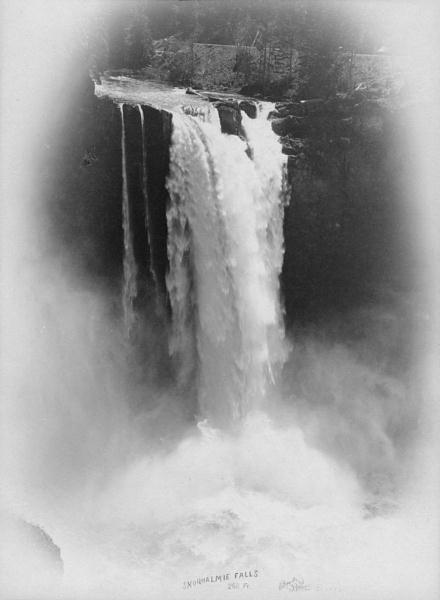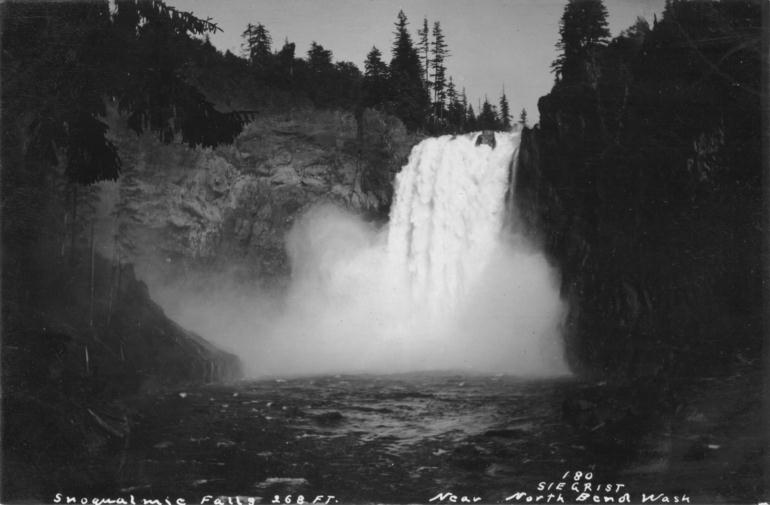|

|
Snoqualmie Falls is 268 feet high and undoubtedly had been a stunning sight to the native people since time
immemorial. By about the mid 1860s Snoqualmie Falls became quite widely known throughout the local area
by the early settlers. This portrait vignette scene of Snoqualmie Falls was made by Boyd and Braas in the early
1890s. William F. Boyd and George H. Braas operated a photography studio at 614 Front Street, in Seattle, from
1890 to 1893. Visible in the background is the railroad main line of the Seattle, Lake Shore and Eastern Railway,
built only a few years earlier in the late 1880s. The railroad access popularized the falls as a tourist attraction. The
Northern Pacific Railroad acquired the Seattle, Lake Shore and Eastern Railway within about five years after this
scene was photographed. Later, from 1898 to 1899, an innovative underground hydroelectric power plant
conceived by Charles Hinckley Baker was built by the Snoqualmie Falls Power Company in a cavern-like chamber
tunneled inside the cliff beside the south side of the falls. To propel the Pelton waterwheels, direct connected to
four three-phase alternating current generators, some water was diverted from above the falls through a vertical
7½-foot diameter penstock to the underground power plant chamber and then returned to the river through
a tailrace tunnel extending to beside the base of the falls.
|
|
 This historical scene, photographed by about 1908 by E.J. Siegrist, shows Snoqualmie Falls before the
construction of Snoqualmie Falls Lodge. The lodge was built in 1919 on the north side of the Snoqualmie River,
just above the brink of the falls. Snoqualmie Falls looks much the same today and is now one of the top tourist
attractions in Washington State, with over 1.5 million visitors annually. Photographer Edward J. Siegrist, commonly
noted as E.J. Siegrist, was from Wisconsin and he became a jeweler and watchmaker at the nearby town of North
Bend, Washington. Edward J. Siegrist became the first treasurer of North Bend, when the town was incorporated
in 1909. About a year after he became the town treasurer he moved to Concrete, Washington, and worked there
as a photographer, jeweler and optician from about 1910–1917.
This historical scene, photographed by about 1908 by E.J. Siegrist, shows Snoqualmie Falls before the
construction of Snoqualmie Falls Lodge. The lodge was built in 1919 on the north side of the Snoqualmie River,
just above the brink of the falls. Snoqualmie Falls looks much the same today and is now one of the top tourist
attractions in Washington State, with over 1.5 million visitors annually. Photographer Edward J. Siegrist, commonly
noted as E.J. Siegrist, was from Wisconsin and he became a jeweler and watchmaker at the nearby town of North
Bend, Washington. Edward J. Siegrist became the first treasurer of North Bend, when the town was incorporated
in 1909. About a year after he became the town treasurer he moved to Concrete, Washington, and worked there
as a photographer, jeweler and optician from about 1910–1917.
Samuel Hancock made a trip to Snoqualmie Falls, led there by native guides, presumably in the year 1850.
Hancock's memoir does not mention the year that he was guided to the falls, but the year 1850 correlates
with some other things mentioned. Edward Dunlop Warbass and Hugh Allen Goldsborough, brother of Rear
Admiral Louis Malesherbes Goldsborough, were led by native guides to Snoqualmie Falls in 1851. There they
noted the falls height, width, and volume of flow. Hugh A. Goldsborough, using the pen name Elis, wrote an article
for the very first issue of the Olympia, Oregon Territory, newspaper The Columbian that included a
description of the trip that he and Edward D. Warbass made to Snoqualmie Falls. Since Hugh A. Goldsborough
worked on the survey of Olympia, Oregon Territory, his pen name Elis was likely a pseudonym chosen from the
ancient Greek region Elis, where Olympia, Greece, is located. The article, titled “Mineral Resources of
Northern Oregon,” was published on page 2 of the September 11, 1852, issue of The Columbian
(Vol. 1, No. 1). In the newspaper article, Hugh A. Goldsborough (aka Elis) noted that while scouting for coal
deposits he and Edward D. Warbass were persuaded to go upriver by the Indians' enthusiastic acclaim
for the lofty precipice over which the river plunged. He wrote in the article that “Thirty-six hours of alternate
rowing, paddling, and poling, brought our party to the foot of the most magnificent sight which has ever yet
blessed the eyes of an Oregonian.” Richard Hyatt Lansdale, an early Whidbey Island settler, also visited
Snoqualmie Falls in 1851. Having been told of the falls, by Isaac Neff Ebey, he had native guides take him there.
After having reached the falls, Richard H. Lansdale continued onward to explore all the way up to the summit of
Snoqualmie Pass.
<< BACK
 Andrew Craig Magnuson
Andrew Craig Magnuson
Forks, Washington
January 20, 2012
Revised November 20, 2018
Copyright © by Andrew Craig Magnuson

|